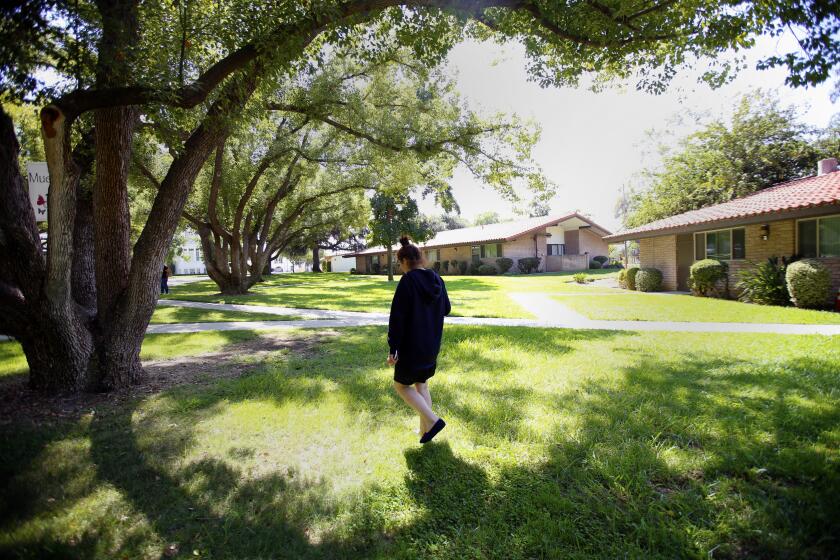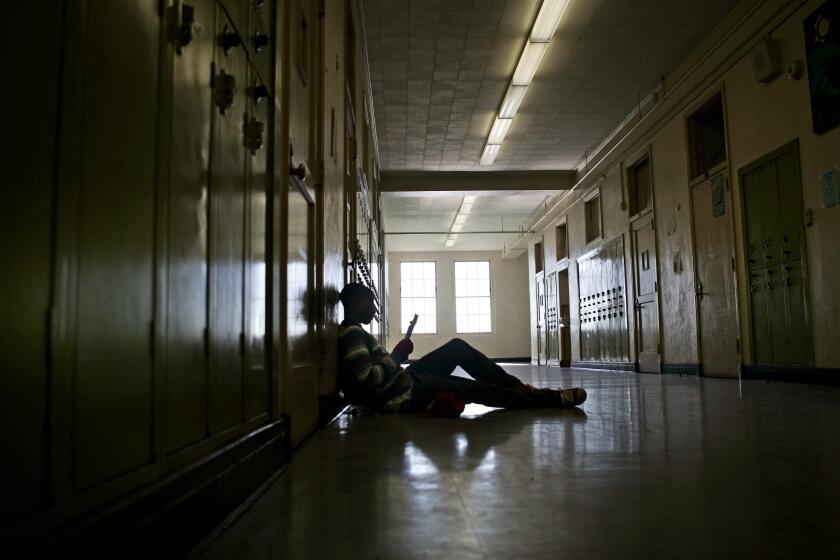A housing effort to keep a new generation of L.A. youth out of homelessness
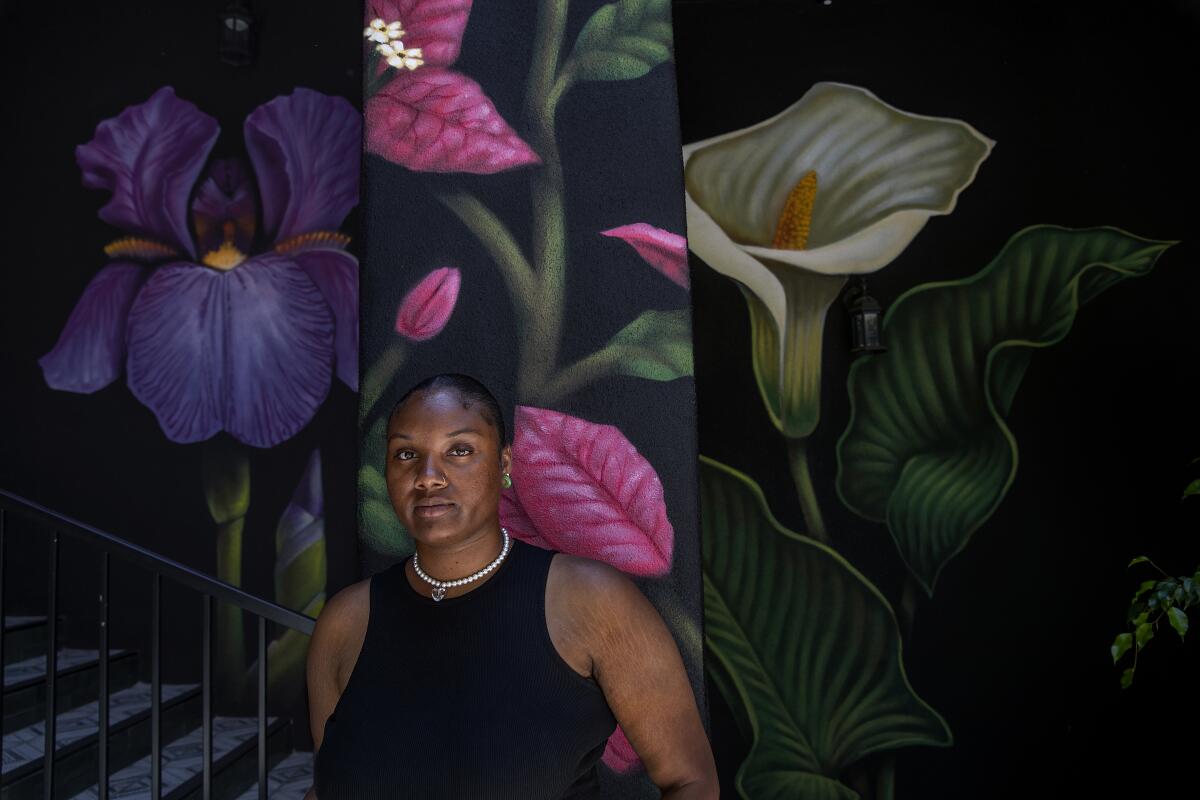
- Share via
Zahria Eaves got up from her sister’s couch in North Hills. It was April 1 — moving day — and she had not slept that night.
Eaves, 22, grew up on the move. She’s lived in 13 cities (she thinks) and spent the last few years “couch hopping.”
When Eaves returned to the West Coast in July 2020 from a stint with her mom in Kansas City, she lived with her dad, and then with her sister, her sister’s boyfriend, and their newborn baby. The four of them lived in a motel until a Section 8 voucher led them to a one-bedroom apartment in North Hills for a spell, before she found herself couch surfing again.
Her dream was go to film school. But she saw no way out of the cycle.
Then, in March, she received an email about the Dunamis House in Boyle Heights, a residence for youth at risk of homelessness.
As the county rushes to house people clustered in tents along the streets of Los Angeles, officials are also exploring youth-based initiatives that seek to avoid leaving another generation with few other options than living on the streets. At the center of the county’s efforts are young people in foster care and incarceration, who are often at the greatest risk of homelessness. Currently, 2,151 young people in Los Angeles are unsheltered, with thousands more at risk.
Surveys show that 20% to 40% of the approximately 1,140 youths leaving foster care in Los Angeles County each year become homeless.
“We have a constant inflow into homelessness that is outpacing the number of people getting housed,” L.A. County Homeless Initiative Executive Director Cheri Todoroff said.
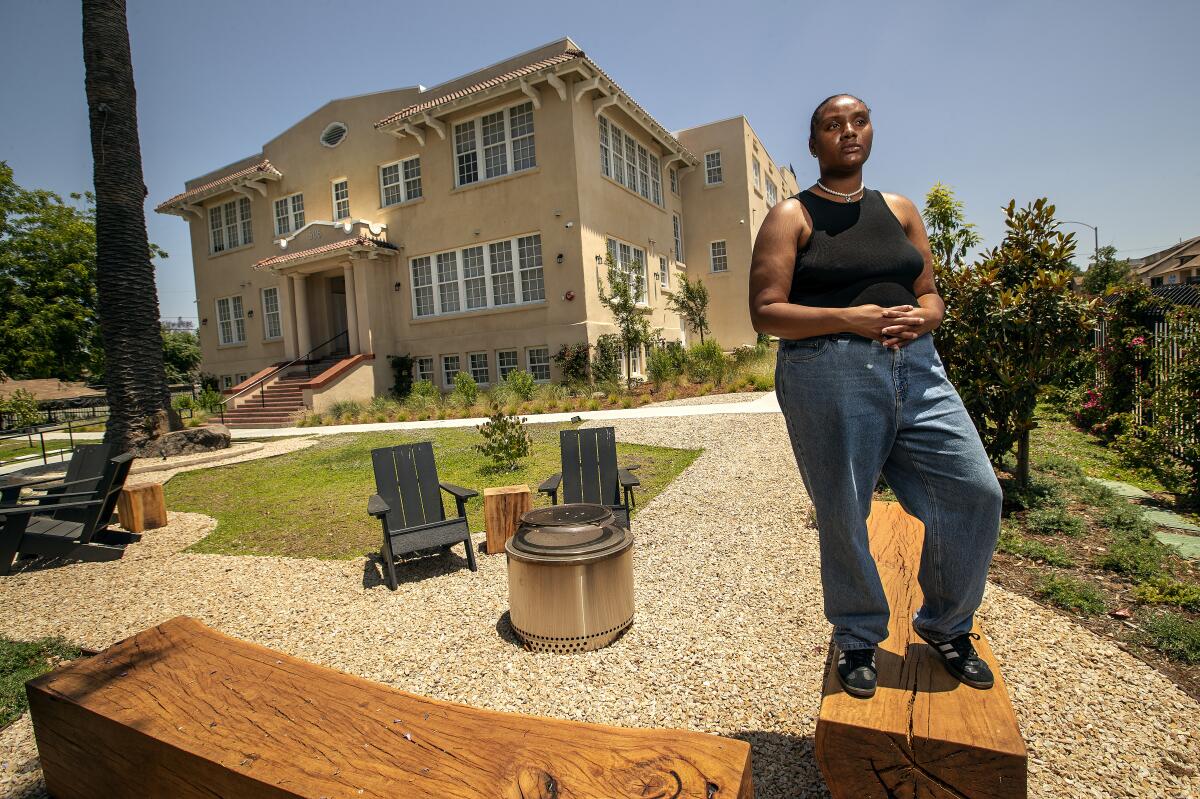
The Dunamis House is one of a number of new housing projects target “transition-aged youth,” who are 18 to 24 years old. Opened since March, it is the first such property funded by Project Homekey, a statewide investment initiative for affordable housing.
Dunamis has 40 rooms, some of which are doubles. The building’s capacity is 64 individuals currently, 54 people live there.
LA Room and Board, a nonprofit, secured the funding in 2020 and partnered with L.A. County to construct Dunamis from an abandoned apartment complex.
Dunamis House resembles a boutique hotel rather than a shelter lined with bunk beds. The lobby’s French doors open to a chic courtyard surrounded by paintings of orange flowers. Above a row of tables and white and green striped cushions is a coffee shop, soon to be staffed by residents.
Eaves, her face streaked with tears, hauled trash bags with all of her belongings into her new home.
Sam Prater, the Dunamis’ founder, welcomed Eaves inside. Words rushed out of Eaves’ mouth, as talking is her coping mechanism when she feels uneasy or overwhelmed with emotion, as she was today.
A public-private model would end the foster care-to-homelessness pipeline in California, according to a study by charitable foundations. State would need to increase rental subsidies.
Serving mostly students at risk of homelessness, Dunamis offers programs for career development, mental health, and academics to ensure students are positioned for success.
Josefina Sebastian, 22, moved to the United States from Guatemala in 2016, a year after her father died. For six years, Sebastian lived in her 70-year-old stepsister’s living room. Her stepsister’s two sons and the couple who rented out the bedroom bustled around the house, interfering with her studies. (Sebastian hopes to become a nurse.) In July 2022, Sebastian moved in with her boyfriend.
Her lack of documentation has made it difficult to get work, so she could not afford to help him with rent, and the instability gnawed at her until she arrived at Dunamis.
“I found peace here,” she said. “It doesn’t matter what happens outside. At the end of the day, I come home, and I’m in peace.”
Sebastian spends most of her time studying. Although there is a study room and several community spaces to work in — each with its own color palette and combination of geometric furniture — she enjoys the view from her back corner room. Behind the building is a sprawling green yard with white beach chairs and tables.
Sebastian has found her own support team at Dunamis. She meets with the wellness coordinator every two weeks, and the education coordinator helped her find a tutor. Staff help her move through the documentation process, which includes her recently completed 150 hours of volunteer work.
Prater believes a place to live can change a young person’s life, but not without support systems in place to guide them toward lifelong stability.
“For our youth who are aged 18 to 24 ... the rest of their lives are ahead of them,” he said.
This philosophy led Prater to solidify a wide set of services focused on academic coaching, career development, mental health, and life skills such as financial literacy and maintaining food security.
Charlie LeBeau, 19, finds the health and wellness coordinators especially helpful in keeping him on track with his goals. He graduated from Santa Monica College in 2019 and will attend UCLA in the fall to pursue a bachelor’s in psychology.
LeBeau’s career prospects excite him — he plans to follow his undergraduate degree with a doctorate. So does his part-time job at Disneyland, for which he gladly boards a two- to three-hour bus ride to reach. After saving money for one or two years, he hopes to have his own apartment.
In 2021, LeBeau fled from an abusive living situation in Northern California to Los Angeles. When he first arrived, he lived in an LGBTQ+ shelter, with concrete rooms that felt like “prison cells.” Back then, LeBeau sported a large jacket stuffed with his important possessions each time he left the shelter, so the other residents wouldn’t steal them.
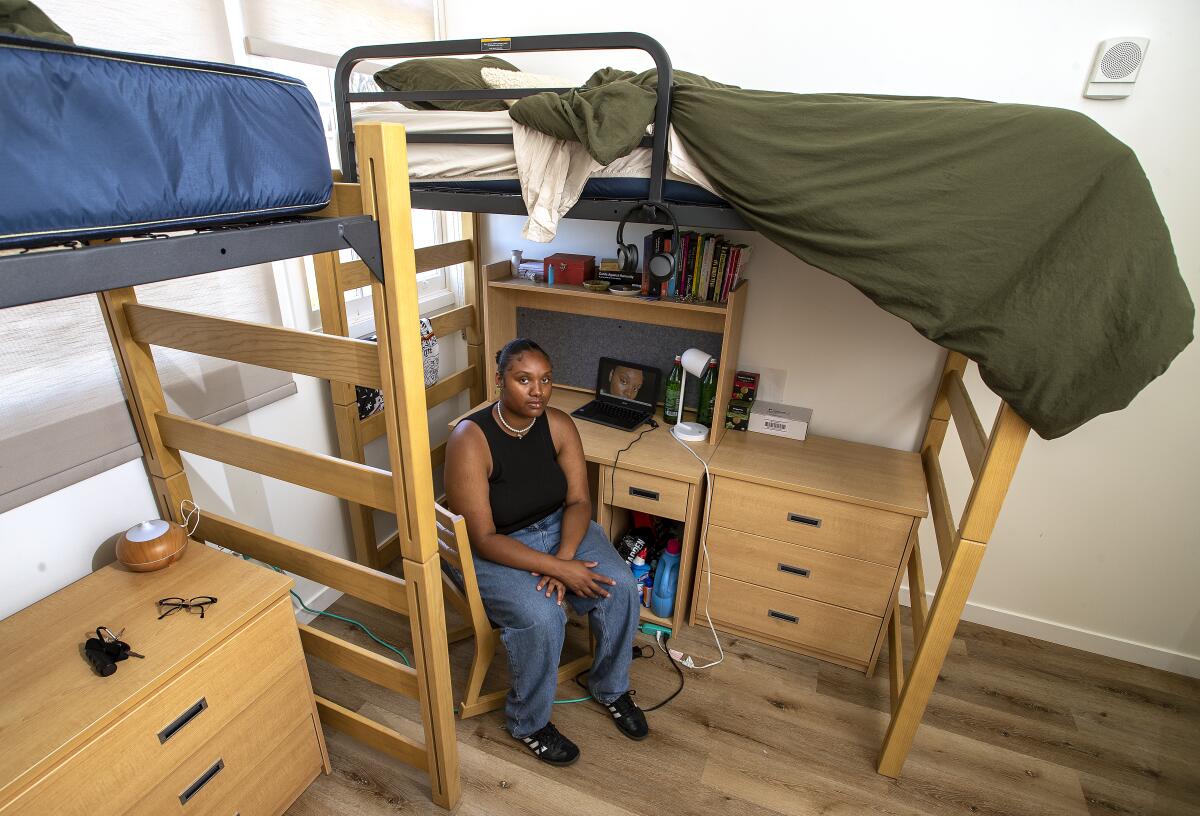
Already weighed down by his jacket, LeBeau would hear people chatter about L.A.’s homelessness problem on the bus and felt “othered.” Staff at one of his former shelters helped him find Dunamis, where he feels like he has a community — and, for once, a sense of normality.
As a former resident director at colleges, Prater noticed that students like LeBeau abandoned their education when chaos and poverty bogged down their lives.
During his most recent resident assistant job at Cal State Northridge, Prater offered food as an incentive for students to attend dorm meetings. To his surprise, some students stuffed days’ worth of food into Tupperware that they lugged back to their rooms. Other students would tell him they were taking time off to get their finances together but never returned.
Prater’s experiences with impoverished students led him to form the nonprofit L.A. Room and Board in 2018. The first project he spearheaded repurposed a sorority house at UCLA into the Opportunity House, a student housing facility similar to Dunamis. L.A. Room and Board then developed the Excelsior House in East Los Angeles.
“We know that higher education isn’t a panacea,” Prater said. “But I do believe that it is the most reliable way to get people out of poverty and into the middle class. If we can support people now, then we can put them on the path to self-sufficiency where they don’t need a program like ours.”
Other youth-based projects like Dunamis are underway.
Supervisor Hilda L. Solis from Los Angeles’ 1st District, where Dunamis is, allocated $255,000 in district funds to Dunamis and plans to fund more housing for youth. The district is looking to develop a 200-unit facility for youth at the site of the former MacClaren Children’s Center.
With its combination of artful architecture and substantial support services, Solis hopes Dunamis “serves as a model” for future youth-based permanent and interim housing projects.
L.A. County Homeless Initiative has also submitted four more applications for similar developments. The county will collaborate with the Department of Child and Family Services to move children leaving the foster care system and incarceration into these new facilities, predicted to open in 2024.
Senate Bill 1341 proposes a monthly, no-strings-attached check to eligible students for five months as they graduate.
Now that she no longer works and school is out of session, Eaves spends most of her time in Dunamis’ courtyard chatting with staff. Last month, she traveled with other residents to New York for a service trip with Prater.
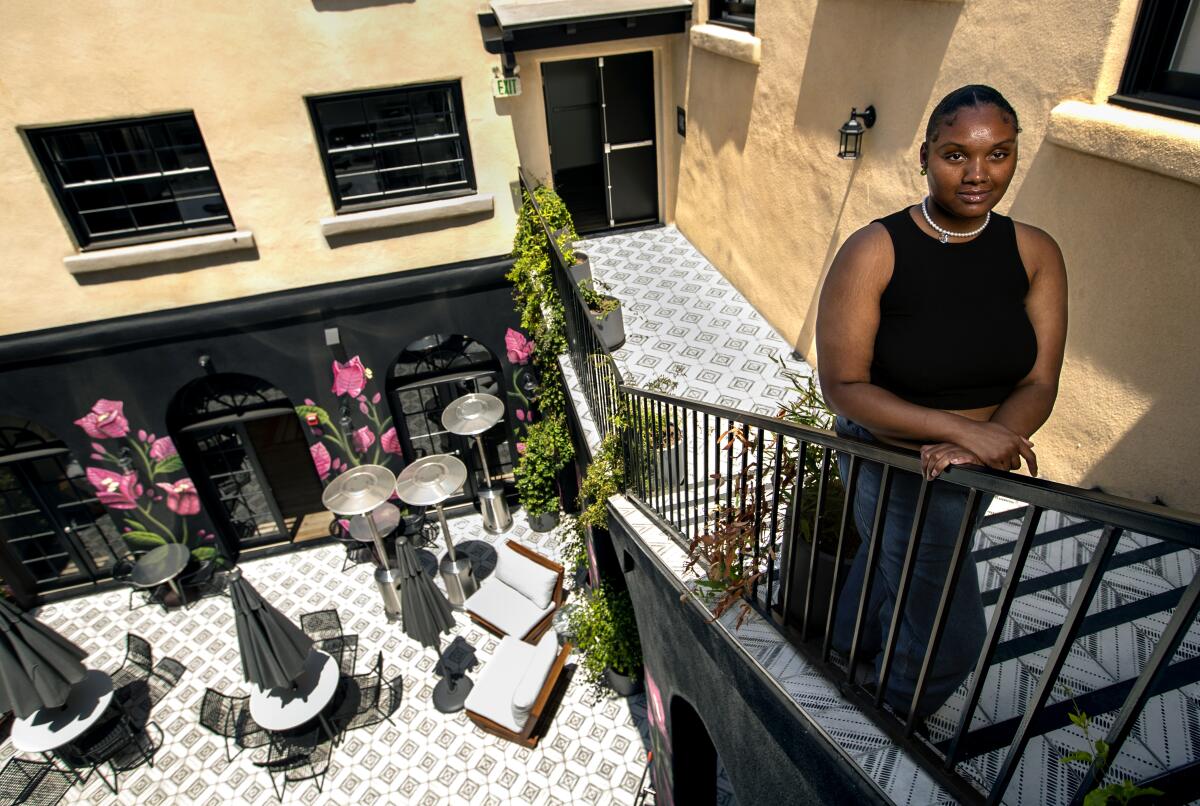
“In the future, I can be an example to my family that it is possible for us to be able to actually live,” Eaves said. “I feel like that’s my goal in life — is to actually live and be internally free.”
She reflects on the morning she first left her sister’s cramped apartment for Dunamis. Eaves had packed her bags and stepped into the Uber, alone. She sobbed with the kind of breathless shaking one experiences after “a whooping.”
The Uber driver watched, puzzled, as tears poured down her face. He drove her away from everything she knew — her family, tight quarters, the obligations she had to everyone around her.
“It was a big step,” Eaves said.
For the summer, she has one main plan: to rest.
She is still adjusting to her newly independent, stable lifestyle — a stark contrast to the time when she lived with her single mother and her mom’s eight children. Now that she does not have to live in “survival mode” and at the whims of her loved ones, Eaves can navigate her own goals, such as making her way through film school.
Another goal is to keep her room clean — for the first time in a while, she has her own space to organize.
More to Read
Sign up for Essential California
The most important California stories and recommendations in your inbox every morning.
You may occasionally receive promotional content from the Los Angeles Times.
